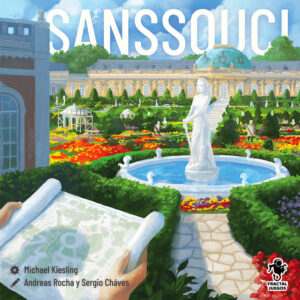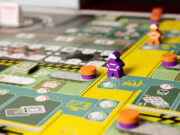 When I was 20 years old and studying history in Berlin, I took a trip with my college classmates to Sanssouci, Frederick the Great’s palace in nearby Potsdam, with a French name that means “Carefree.” Even though today the trip is about 25 minutes by car across suburban Berlin, back then I had to cross a major international border and go behind the Iron Curtain. It was the old days of the Wall and East Germany, so the East German government barely took care of this old relic of the days the Marxists would call feudalism, and the place was pretty run down. I have not been back since the reunification of Germany but I am told the post-communist restoration has returned the palace and its gardens to its former glory.
When I was 20 years old and studying history in Berlin, I took a trip with my college classmates to Sanssouci, Frederick the Great’s palace in nearby Potsdam, with a French name that means “Carefree.” Even though today the trip is about 25 minutes by car across suburban Berlin, back then I had to cross a major international border and go behind the Iron Curtain. It was the old days of the Wall and East Germany, so the East German government barely took care of this old relic of the days the Marxists would call feudalism, and the place was pretty run down. I have not been back since the reunification of Germany but I am told the post-communist restoration has returned the palace and its gardens to its former glory.
This seems to be a recurring theme of this poor palace, because in the game Sanssouci by veteran designer Michael Kiesling (known best nowadays for Azul), you play as 18th-century landscape architects brought in to restore the palace gardens to their former glory after they have fallen into ruin at the end of the reign of Frederick the Great. And with its 2022 reissue, the game itself has been revamped. The classic rules are untouched, but the look has been fully updated to, yes you guessed it, restore the game to its former glory.
Gameplay Overview:
Renovation recursion notwithstanding, the game is a masterpiece of sorts. With a lean economy of rules that you can explain in a matter of minutes, you can be off and running with a game that offers a surprising amount of interesting choices for an old-school tile layer. Sanssouci (the game) has no real thematic connection to Sanssouci the palace or to Prussian history or to landscape architecture or to really anything.

It is just an abstract puzzle, but it’s a very elegant one that manages to have just enough player interaction (mostly via the tile draft) to avoid devolving into multiplayer solitaire. I am certain it would have been a real hit with the original occupant of Sanssouci, as Frederick the Great was a true polymath who would have loved Euro games if they’d existed in his day.
Players start with 18 cards, nine that have just colors on them and nine with pictures of specific garden elements, like a gazebo or a fountain. You will draft 18 tiles, one per card, with color cards letting you choose among four tiles, based on their position on the draft board, and those garden elements letting you draft any of the available tiles with that symbol on it, or becoming wild cards if that symbol is not on display at all.
Set up is easy enough: players lay out their private segments of the garden, plop down nine nobles at the top of each column on their tableau, draw 10 tokens for the common draft pile and draw the first two on their personal deck of 18 cards, and off you go.
You’re trying to complete rows and columns of the garden for end-game points, while at the same time aiming to create paths for your nine nobles to create unobstructed itineraries to high-point spaces. Those noble perambulations are what generate the in-game points (1-6 points if you are able to move), and if you throw in a couple of hidden goals that can score up to 6 points apiece, you’ve got a tight, tense tile-layer that you can play in 20-30 minutes and is satisfying without being too heavy.

Game Experience:
Because each round is driven by players playing one of their cards, 18 cards means 18 rounds. In each round you play a card which determines which tile you can draft from a common pool of an ever-refreshed set of 10 tiles face-up tiles. You always have two cards in your hand (until the last round) and play one of them, taking your choice of tiles it entitles you to, and placing it into your private section of the Sanssouci gardens. After each placement, you have the option to move one of the nobles down a garden path to score some points, heeding some rules on movement that can lead to some heartbreak if you aren’t planning ahead on where you place your tiles.

You can get up to 6 points for a noble move, so you’d like to avoid having to either skip your noble phase (and get 0) or take a weak move for 1 or 2, while at the same time keeping all your potential end-game points in mind. There are a few tactical tricks involved to separate the apprentices from the masters to transform your symbol cards into wildcards, but generally, the whole point is to rack up noble points during the game, score lots of rows and column points at the end of the game, and then ideally get both of your secret objective cards maxed out before you reveal them at the end of the game. And then win, of course!
The first 16 rounds all go the same: play a card, place a tile you draft based on the card, then move a noble if you can. On the 17th round, there are no more cards to draw, so after you play your 17th card, on the 18th round, you have just one card in hand and hence no choice as to which card to play. Players all moan if this 18th draw is useless, or cheer if they manage to draft a useful final tile, and then you move to end-game scoring.
What differs from round-to-round is that your garden starts to fill up with tiles, making it easier for nobles to move further down their paths, scoring higher points. So early turns are usually 2- or 3-pointers, whereas by the end you’re hoping each turn earns you 6, which is the maximum. Woe is the architect with too many turns where, because of dead-ends, a noble can only move from the starting gate to the first row, earning just 1 point, or worse still, has no valid move at all and earns 0. When this happens you can hear the ghost of Frederick the Great crying out one of his (likely misattributed) maxims from a remote corner of the garden: “L’audace, L’audace! Toujours L’audace!”
Final Thoughts:

When a game causes players to groan or cheer over whether they get a useful tile, you know it has succeeded in the greatest boardgame magic trick there is: getting players to care deeply about something as silly as plopping squares down onto a grid. Sanssouci manages this with aplomb. My two tablemates instantly wanted a second go after our first game ended, and even though I came in second to my garden-savvy wife both times we played, I am eager for more chances to eke out a win when we next sit down to play Sanssouci.
As a matter of personal taste, my favorite games tend to have more theme, more complexity, and more depth than Sanssouci, meaning I am not the game’s ideal target. Despite that, I very much enjoyed the game. It’s so much easier to get to the table than the more complex Euros I gravitate towards, but it offered some tension and strategic thinking a step or two beyond, say, Carcassonne, while also playing quickly enough to ensure two or even three plays are possible in a single sitting.
As long as you don’t ask too many questions about why the nobles are exploring a half-finished garden, you can let the half-hearted feints at a theme drift away and just treat it as a fun, quick puzzle game for 2-4 players. It’s a solid filler game that could become a full meal as a best-of-three series, easy enough that you could teach a non-hobbyist while “thinky” enough that you won’t feel like you’re dumbing things down just to play something accessible. So it’s a nice addition to a well-stocked game library and it holds up well despite being close to a decade old. Basically, it just works.
Final Score: 4 Stars – I and look forward to teaching/playing it many times more before the next time someone decides to refurbish Sanssouci yet again.
 Hits:
Hits:
• So easy to teach the rules and get the game going.
• Surprisingly tense as the tiles you need can get drafted out from under you.
• Quick game play keeps things moving.
Misses:
• This is a game about Prussian garden architecture. Really? Actually no.
• The game rewards a bit more planning than might be obvious on first try, so if you don’t like to think ahead a turn or two, you might get frustrated when you keep coming in last.






















